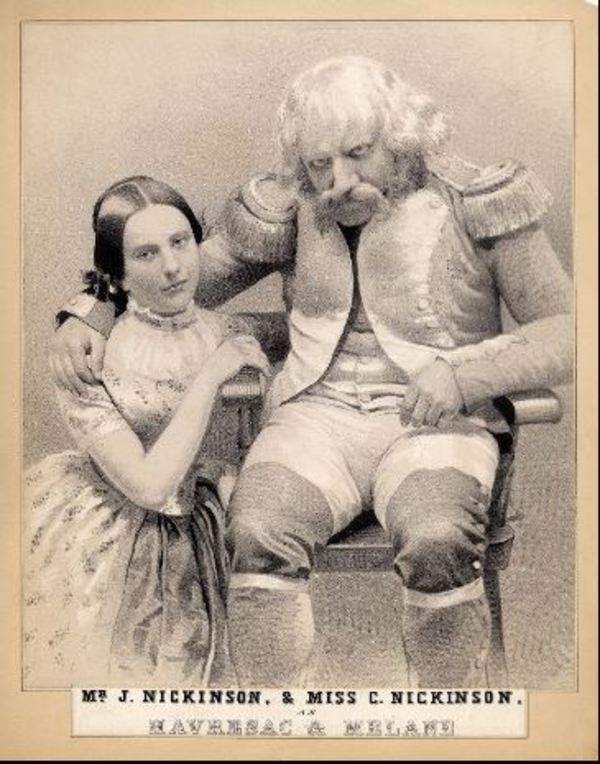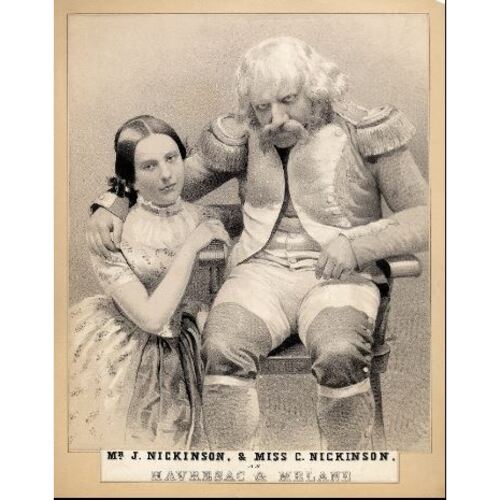
Source: Link
NICKINSON, CHARLOTTE (Morrison), actress and theatre manager; b. 16 Feb. 1832 at Quebec, daughter of John Nickinson* and Mary Ann Talbot; m. 22 April 1858 Daniel Morrison* in Toronto, and they had two sons and two daughters; d. there 8 Aug. 1910.
When Charlotte Nickinson was born her father was a sergeant in the British army in Lower Canada and an amateur actor. In 1836 he bought his discharge in order to pursue an acting career. For the next 15 years the growing family lived mainly in New York City, with John spending summers acting in Albany, Utica, Saint John, N.B., and Montreal.
Charlotte, said to have been named after Charlotte Saunders Cushman, an American actress with whom her father frequently performed, made her début in New York in June 1846 at the Vauxhall Garden Theatre. She was 14. The next season she joined her father in the Olympic Theatre company and they became an inseparable team. She was remembered particularly for playing Melanie to her father’s Havresack in Dion Boucicault’s Napoleon’s old guard and for taking the role of Florence in John Brougham’s adaptation of Charles Dickens’s Dombey and son. Her final New York appearance was in Isaac Clarke Pray’s tragedy Poetus Cæcinna in October 1851.
Nickinson formed his own troupe that year with Charlotte as the centre-piece, and later added his other children, Eliza, Virginia, Isabella, and John. Brief visits to Toronto in the summers of 1851 and 1852 were acclaimed, as was the 1852 tour to Kingston, Montreal, and Quebec. Charlotte, now 20, created a stir in the city of her birth. Billed as “La Jeune Quebecoise,” she was “nightly called before the curtain.” Her repertoire included Shakespeare’s Ophelia, Lady Teazle in Sheridan’s The school for scandal, and Lady Gay Spanker in Boucicault’s comedy London assurance. Encouraged by the company’s Canadian reception, Nickinson leased Toronto’s Royal Lyceum Theatre from 1853 to 1859. Charlotte, his leading lady, was tall, slim, and striking, and she was blessed with a “beautiful musical voice,” a “delicious” and infectious laugh, and a gift for comedy. Her warmth, charm, and unfailing good taste made her perennially popular and respected.
Charlotte retired from the stage on 21 April 1858, the night before she married Daniel Morrison, a newspaper editor who had reviewed her performances. His career took them to Quebec, London (Ont.), and New York. While raising their children Charlotte was able in January 1864 to accept a theatrical engagement from John Wellington Buckland and his wife, Kate [Horn*], to perform at the Theatre Royal, in Montreal. In 1868 they returned to Toronto, where Morrison wrote for the Daily Telegraph until his death two years later.
Obliged to return to the stage to support herself, Charlotte followed in her father’s footsteps and assembled a company of actors for a week’s engagement in the summer of 1871 and again for four weeks in the spring of 1872. Her popularity had not diminished. The Mail suggested that “Toronto can well support two theatres in the future.” The population was approaching 70,000 and the Royal Lyceum was small and nearly 25 years old. Charlotte and several dignitaries petitioned the provincial government in January 1873 to be allowed to build and operate a new theatre. Assent was given, and on 21 Sept. 1874 the Grand Opera House (known during her tenure as Mrs Morrison’s Grand Opera House), a beautifully appointed four-storey structure, was opened. Under her management leading players such as Adelaide Neilson, Edwin Thomas Booth, and Lawrence Patrick Barrett appeared with her resident stock company before fashionable audiences. When the Grand sponsored a visiting production Charlotte made personal appearances elsewhere or toured her troupe to Ottawa and Hamilton. She gave several future luminaries their débuts, including John Henry Miller and Ida Van Cortland, who later managed her own Canadian touring ensemble. But the recession of 1873–79 and her insistence on refined and sometimes dated fare made her commercial venture vulnerable. By the end of the 1877–78 season salaries were not being paid and she was forced to let her actors go and give up her role as manager. She was succeeded by Augustus Pitou the elder, who had been a member of the company. The era of the local stock company performing with a visiting star was being superseded by the age of the pre-packaged tour or “combination” show (company plus star) out of New York. Once an important producer of theatre, the Grand Opera House succumbed to being a link in an American distribution chain.
Charlotte continued to make guest appearances with amateur societies and give readings, but she gradually channelled her energies into charitable and church work, becoming a prominent member of the National Council of Women of Canada and of the Women’s Canadian Historical Society of Toronto. She also helped organize and became president of the Toronto Relief Society. After a prolonged illness she died at her home in Toronto, survived by two married daughters and a son. Hector Willoughby Charlesworth*, a theatre critic, talked of “the glories of Mrs. Morrison’s regime.” She was a gracious and accomplished Canadian professional in a time when there was little in the theatre that could be designated Canadian.
ANQ-Q, CE1-71, 11 mars 1832. MTRL, Taverner coll., Ida Van Cortland (Taverner), address containing reminiscences of her years on the stage, 1918, pp.l–2. Daily Mail and Empire, 9 Aug. 1910: 4. Daily Telegraph (Toronto), 12 April 1870. Evening Telegram (Toronto), 9 Aug. 1910: 7. Globe, 10 Aug. 1910: 5. Hamilton Spectator, 6 April, 27 Oct, 1874; 22 Jan., 9 Oct. 1875; 23 May 1876; 29 Nov. 1880; 31 Oct. 1883. Mail (Toronto), 3 June 1872. Toronto Daily Star, 9 Aug. 1910. J. R. Aikens, “The rival operas: Toronto theatre, 1874–84” (phd thesis, 2v., Univ. of Toronto, 1975). T. A. Brown, History of the American stage; containing biographical sketches . . . from 1733 to 1870 (New York, 1870; repr. [1969]). Mrs William Campbell, “Toronto theatres in the old days,” York Pioneer and Hist. Soc., Report (Toronto), 1930: 13–15. H. [W.] Charlesworth, “Music and drama,” Saturday Night, 15 July 1922: 6. M. D. Edwards, A stage in our past, English-language theatre in eastern Canada from the 1790s to 1914 ([Toronto], 1968). Franklin Graham, Histrionic Montreal; annals of the Montreal stage . . . (2nd ed., Montreal, 1902; repr. New York and London, 1969). Lawrence Hutton, Plays and players (New York, 1875), 52. J. N. Ireland, Records of the New York stage from 1750 to 1860 (2v., New York, 1866–67; repr. 1966). Look at the record: an album of Toronto’s lyric theatres, 1825–1984, comp. J. P. Baillie, intro. William Kilbourne (Oakville, Ont., 1985). H. J. Morgan, Sketches of celebrated Canadians . . . (Quebec and London, 1862; repr. Montreal, 1865). G. C. D. Odell, Annals of the New York stage (15v., New York, 1927–49), 5: 243, 368; 6: 62. P. B. A. O’Neill, “A history of theatrical activity in Toronto, Canada: from its beginnings to 1858” (phd thesis, 2v., La State Univ., Baton Rouge, 1973). The Oxford companion to American theatre, ed. Gerald Bordman (New York, 1984), entries for Cushman, Miller, and Pitou. Types of Canadian women (Morgan).
Cite This Article
David Gardner, “NICKINSON, CHARLOTTE (Morrison),” in Dictionary of Canadian Biography, vol. 13, University of Toronto/Université Laval, 2003–, accessed December 31, 2025, https://www.biographi.ca/en/bio/nickinson_charlotte_13E.html.
The citation above shows the format for footnotes and endnotes according to the Chicago manual of style (16th edition). Information to be used in other citation formats:
| Permalink: | https://www.biographi.ca/en/bio/nickinson_charlotte_13E.html |
| Author of Article: | David Gardner |
| Title of Article: | NICKINSON, CHARLOTTE (Morrison) |
| Publication Name: | Dictionary of Canadian Biography, vol. 13 |
| Publisher: | University of Toronto/Université Laval |
| Year of publication: | 1994 |
| Year of revision: | 1994 |
| Access Date: | December 31, 2025 |



